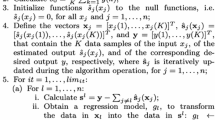Abstract
It is practically and theoretically significant to approximate and simulate a system with fuzzy inputs and fuzzy outputs. This paper proposes a extreme learning machine (ELM)-based fuzzy regression model (\({{\rm FR}}_{{{\rm ELM}}}\)) in which both inputs and outputs are triangular fuzzy numbers. Algorithm for training \({{\rm FR}}_{{{\rm ELM}}}\) is designed, and its computational complexity is analyzed. Furthermore, the convergence and error estimation for \({{\rm FR}}_{{{\rm ELM}}}\) are discussed. Numerical simulations show that the proposed \({{\rm FR}}_{{{\rm ELM}}}\) can effectively approximate a fuzzy input and fuzzy output system.



Similar content being viewed by others
Explore related subjects
Discover the latest articles, news and stories from top researchers in related subjects.References
Arabpour AR, Tata M (2008) Estimating the parameters of a fuzzy linear regression model. Iran J Fuzzy Syst 5(2):1–19
Berenji HR (1992) Fuzzy logic controllers. An introduction to fuzzy logic applications in intelligent systems. Springer, New York
Choi SH, Buckley JJ (2008) Fuzzy regression using least absolute deviation estimators. Soft Comput 12(3):257–263
Diamond P (1988) Fuzzy least squares. Inf Sci 46(3):141–157
Diamond P, Körner R (1997) Extended fuzzy linear models and least squares estimates. Comput Math Appl 33(9):15–32
D’Urso P (2003) Linear regression analysis for fuzzy/crisp input and fuzzy/crisp output data. Comput Stat Data Anal 42(1):47–72
Fu AM, Dong CR, Wang LS (2014) An experimental study on stability and generalization of extreme learning machines. Int J Mach Learn Cybern. doi:10.1007/s13042-014-0238-0
Fu AM, Wang XZ, He YL, Wang LS (2014) A study on residence error of training an extreme learning machine and its application to evolutionary algorithms. Neurocomputing. doi:10.1016/j.neucom.2014.04.067
Gani AN (2012) A new operation on triangular fuzzy number for solving fuzzy linear programming problem. Appl Math Sci 6(11):525–532
Hassanpour H, Maleki HR, Yaghoobi MA (2009) A goal programming approach to fuzzy linear regression with non-fuzzy input and fuzzy output data. Asia–Pac J Oper Res 26(5):587–604
Hasanpour H, Maleki HR, Yaghoubi MA (2010) Fuzzy linear regression model with crisp coefficients: a goal programming approach. Iran J Fuzzy Syst 7(2):19–39
Hojati M, Bector CR, Smimou K (2005) A simple method for computation of fuzzy linear regression. Eur J Oper Res 166(1):172–184
Hong DH, Lee S, Do HY (2001) Fuzzy linear regression analysis for fuzzy input–output data using shape-preserving operations. Fuzzy Sets Syst 122(3):513–526
Huang GB, Chen L, Siew CK (2006) Universal approximation using incremental constructive feedforward networks with random hidden nodes. IEEE Trans Neural Netw 17(4):879–892
Huang GB, Wang DH, Lan Y (2011) Extreme learning machines: a survey. Int J Mach Learn Cybern 2(2):107–122
Huang L, Zhang BL, Huang Q (1998) Robust interval regression analysis using neural networks. Fuzzy Sets Syst 97(3):337–347
Huang GB, Zhu QY, Siew CK (2006) Extreme learning machine: theory and applications. Neurocomputing 70(1):489–501
Ishibuchi H, Tanaka H (1992) Fuzzy regression analysis using neural networks. Fuzzy Sets Syst 50(3):257–265
Kao C, Chyu CL (2002) A fuzzy linear regression model with better explanatory power. Fuzzy Sets Syst 126(3):401–409
Kao C, Chyu CL (2003) Least-squares estimates in fuzzy regression analysis. Eur J Oper Res 148(2):426–435
Kwang HL (2005) First course on fuzzy theory and applications. Adv Soft Comput 27:129–151
Pedrycz W (1990) Fuzzy sets in pattern recognition: methodology and methods. Pattern Recognit 23(1):121–146
Rabiei MR, Arghami NR, Taheri SM, Sadeghpour B (2013) Fuzzy regression model with interval-valued fuzzy input-output data. In: Proceedings of 2013 IEEE international conference on fuzzy systems, pp 1–7
Redden DT, Woodall WH (1994) Properties of certain fuzzy linear regression methods. Fuzzy Sets Syst 64:361–375
Sakawa M, Yano H (1992) Fuzzy linear regression analysis for fuzzy input-output data. Inf Sci 63(3):191–206
Sakawa M, Yano H (1992) Multiobjective fuzzy linear regression analysis for fuzzy input-output data. Fuzzy Sets Syst 47(2):173–181
Tanaka H, Uejima S, Asai K (1982) Linear regression analysis with fuzzy model. IEEE Trans Syst Man Cybern 12(6):903–907
Wang XZ, Shao QY, Miao Q, Zhai JH (2013) Architecture selection for networks trained with extreme learning machine using localized generalization error model. Neurocomputing 102:3–9
Wu HC (2003) Linear regression analysis for fuzzy input and output data using the extension principle. Comput Math Appl 45(12):1849–1859
Yang MS, Ko CH (1996) On a class of fuzzy \(c\)-numbers clustering procedures for fuzzy data. Fuzzy Sets Syst 84(1):49–60
Yang MS, Lin TS (2002) Fuzzy least-squares linear regression analysis for fuzzy input-output data. Fuzzy Sets Syst 126(3):389–399
Yen KK, Ghoshray S, Roig G (1999) A linear regression model using triangular fuzzy number coefficients. Fuzzy Sets Syst 106(2):167–177
Zhang AW (2012) Contrast between fuzzy linear least-squares regression based on different distances. J Jiangsu Univ Sci Technol 26(5):509–513
Author information
Authors and Affiliations
Corresponding author
Additional information
We thank three anonymous reviewers whose valuable comments and suggestions help us significantly improve this paper. This work is supported by China Postdoctoral Science Foundation (2015M572361), National Natural Science Foundations of China (61503252), and Hebei Province Science and Technology Support Program Project (13210351).
Rights and permissions
About this article
Cite this article
Liu, Ht., Wang, J., He, Yl. et al. Extreme learning machine with fuzzy input and fuzzy output for fuzzy regression. Neural Comput & Applic 28, 3465–3476 (2017). https://doi.org/10.1007/s00521-016-2232-9
Received:
Accepted:
Published:
Issue Date:
DOI: https://doi.org/10.1007/s00521-016-2232-9




